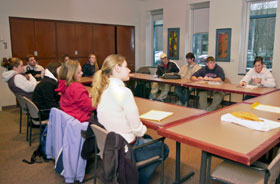Students Document A Day In
Their Lives for Archival Record
 |
|
Students in a First Year Experience class discuss their recent visits to museums and archival collections. The course is designed to encourage students to appreciate these resources on campus. |
|
Photo byJordan Bender
|
There were Midnight Madness tickets, and menus, candy wrappers and class notes. Someone even included an empty Doritos bag marked “lunch.”
These items were among many that students used in an assignment, “A Day in My Life as a Student.” The project was part of a First Year Experience course focusing on collections and archives at the University.
The course was developed to give students “a better understanding of the purpose that museums and archives serve at the University,” says Tom Wilsted, director of the Thomas J. Dodd Research Center, which houses the University Archives. Wilsted team-teaches the class with Leanne Harty, director of the Connecticut State Museum of Natural History and Connecticut Archaeology Center, and Thomas Bruhn, curator of art collections at the William Benton Museum of Art. They hope the course encourages students to visit museums and archives outside of the University, as well as those on campus.
Students spend class time at the Benton Museum, the Dodd Center,
the UConn Sports Museum, and the biology collections.
“We want students to know there’s life beyond the Internet,” says Bruhn, “and we want to broaden their UConn experience.”
The 14 students in this semester’s class were particularly excited during their visit to the University Archives, where they saw the University’s first school newspaper, early yearbooks, and historical maps of the Storrs campus. Learning through the archival material that in UConn’s early days students were reprimanded for breaking curfew, or dismissed from college for swearing or drinking, was fascinating to them, Harty says.
Wilsted says that although there are early course catalogs and newspapers in the archives, material documenting people’s day-to-day lives are not routinely donated.
That’s when the instructors came up with the idea for a “Day-in-the Life” project for their class.
Students were told to pick a day and document it in a scrapbook or organized folder. They had to include a written diary of their activities, and supplement it with photos, e-mails, websites visited, campus flyers, class materials, and other items. No perishables were permitted. They had the option to donate their projects to the Dodd Center for permanent inclusion in the archives.
“Part of the exercise was to have students look at their lives in terms of material culture,” Harty says. “In class I stress that the cool thing about archaeology and anthropology is that artifacts are very often just about regular people’s lives.”
One student’s scrapbook was peppered with magazine images, ranging from shoes and sunglasses to a cell phone and a SpongeBob cartoon figure. Others were packed with newspaper articles, weather maps, photographs, and postcards.
Freshman Jeff Meyer says the project “gave us the opportunity to leave our legacy here at the University. I wouldn’t mind having people read my project many years from now, and I think it would be interesting to see how my daily routine compares to a student’s routine in the future.” Meyer’s scrapbook included material on flag football.
Danielle McAdams, a freshman, says the assignment was an opportunity “to leave
a piece of myself at UConn,” noting that it helped her and others “realize
that the idea of a valuable collection extends beyond art museums and ancient artifacts
found under a glass casing. It allowed us to see that our lives and the daily activities
we perform will one day be valuable, not only to us and our feelings
of nostalgia, but to those who find interest in our generation.”

